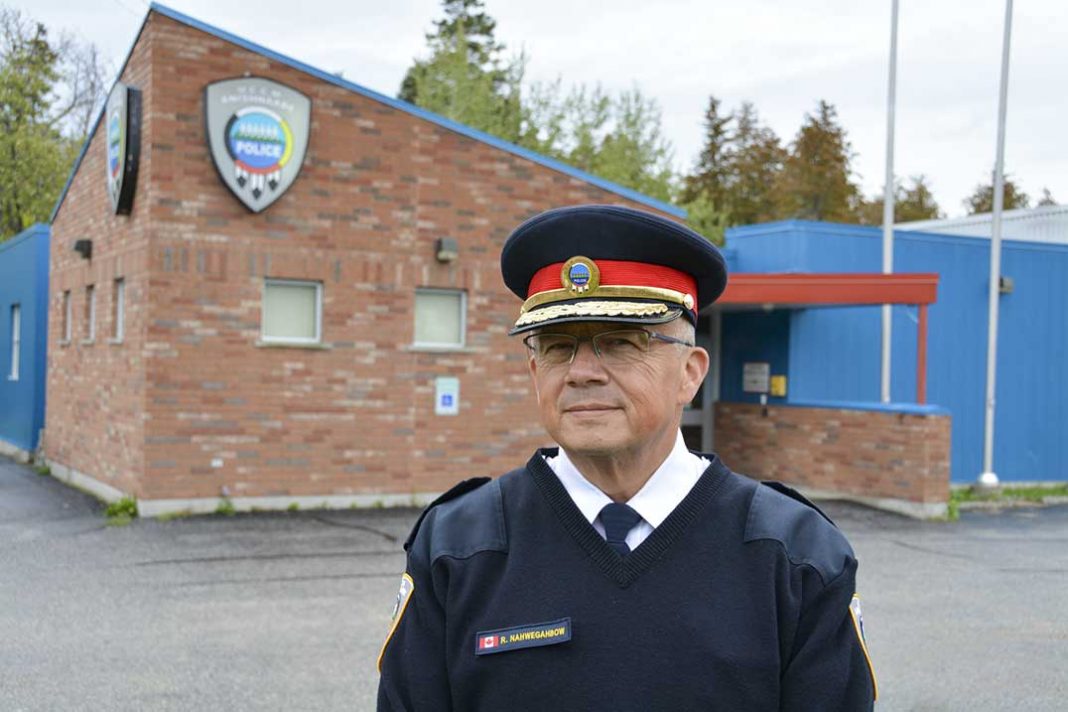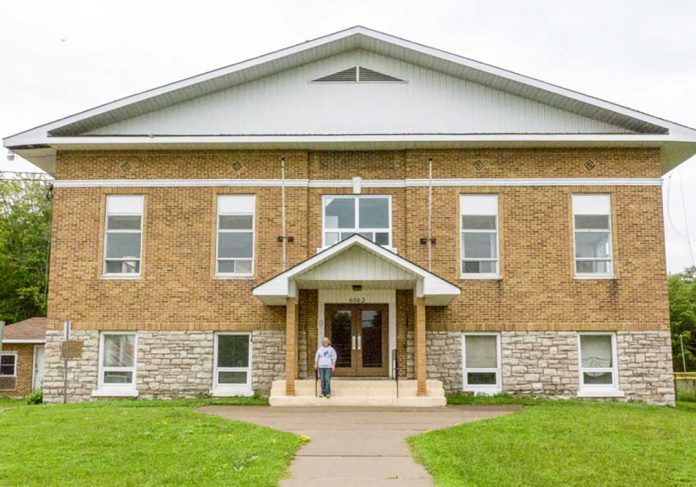M’CHIGEENG – After over 25 years of service to the United Chiefs and Councils of Manitoulin (UCCM) Anishnaabe Police Service, Rodney Nahwegahbow is hanging up his hat as chief of police with the assurance that he has helped to create a strong, progressive force with a dedicated cadre of uniformed officers and civilian staff.
Mr. Nahwegahbow was sworn in as chief of the UCCM Police in June of 2010, taking over from outgoing police chief Albert Beaudin, only the second police chief since the UCCM’s inception.
“I feel honoured to have been part of this police service,” he tells The Expositor in an exit interview.
Mr. Nahwegahbow began his career as an officer in October of 1989 in Still River and then Espanola detachments as the District Native Liaison Officer with the Ontario Provincial Police, serving the areas between Magnetawan, Serpent River and all of Manitoulin.
“I became very closely acquainted with the Island area, especially as a Whitefish River First Nation (WRFN) band member,” he explains. Mr. Nahwegahbow recalls the preliminary discussions with the chiefs in the early 1990s about the formation of a tribal police service. At the time, WRFN had one officer (Rendell McDonald) and M’Chigeeng had two (Ray Corbiere and Albert Beaudin).
In 1992 those communities received word that they would receive more funding for additional officers to help their existing complement, among them Mr. Nahwegahbow. Over the next two-and-a-half years the officers began to take calls in the other UCCM communities and in October 1995, the UCCM Anishnaabe Police Service was formed. It was five years after that Mr. Nahwegahbow became chief of police.
Mr. Nahwegahbow has many things he’s proud of over his time with the UCCM, but one thing he comes back to time and again is his training to become a DARE instructor. DARE stands for Drug Abuse Resistance Education and Mr. Nahwegahbow said he was able to teach over 300 children about the dangers of drug and alcohol abuse over that time. It was this, he says, that helped put him on the course to community building that he finds so incredibly important with the UCCM Police.
“It was here that I really felt the impact of community-based policing,” he says. “Connecting with youth is key. My focus really became to try and bridge that gap with youth with an aim to provide frontline policing, the building of trust and community engagement. I tried to move that philosophy forward.”
Mr. Nahwegahbow is also pleased with the creation of Maamwi Naadamadaa, which translates to ‘let’s work together.’ Maamwi Naadamadaa incorporates all the United Chiefs and Councils of Mnidoo Mnising (UCCMM) partners—Kenjgewin Teg, UCCMM, Kina Gbezhgomi, UCCM Justice Program, UCCM Police, Ojibwe Cultural Foundation Mnidoo Mnising Employment and Training and Gwekwaadziwin Miikan.
“We try really hard to focus on programs,” he continues. “And we do this with a lack of funding.”
The UCCM Anishnaabe Police can also boast the first publically-funded First Nation social navigator and also held a summer leadership program this summer, a first for the force.
“As a small underfunded police force we meet the demands of our community,” Mr. Nahwegahbow says with pride.
“Having programming is an ongoing effort, while improving the general overall safety of our communities,” he adds, noting that programs such as Crime Stoppers and Neighbourhood Watch have been added. “And programs that are requested by the communities we also offer on request.”
Other UCCM firsts include a new records management system, RMS NICHE, installed in 2012, which connects police reports to a majority of other Ontario police services; the purchase of an electronic fingerprint scanner; police assigned cell phones for each officer with access to shift schedule and programs such as the digital brief mental health screener; the UCCM Police voluntary vulnerable persons registry and high risk situation table associated to their social navigator; violent threat risk assessment with active protocols with affiliated service providers and schools; and Addressing Risk for Improved School Success (ARISS), which addresses absenteeism.
“I take pride in knowing we’ve made a difference,” Mr. Nahwegahbow says. “There are still tragic circumstances, as in any community, but we try to strategize about the overall response.” An example of this is allowing for cultural ceremonies to take place when such a tragedy occurs, such as a smudging or pipe ceremony. “We need to be a culturally sensitive police force.”
Typically, he notes, the police are viewed as ‘sleeping outside the encampment.’ “It’s like working between two worlds. It’s important to have a lasting impact on where those communities will be years down the road.”
The force also received funding for ‘women and gender diversity’ to help them battle the higher than average rates of domestic violence. “Our rate is four times that of the province; it used to be seven times.”
In the future, Mr. Nahwegahbow says the force needs to continue building relationships. “That is the overarching responsibility. That’s our promise.”
“I’ve come to learn and respect that the public sees me as First Nation, but also as a representative of the government. It makes me feel as though I have to be almost apologetic when I speak with people.” A balancing act of walking the aforementioned two worlds.
While moving forward, the police force must be able to look back, even as far back as centuries, to work on the trust that has been lost, he adds.
Policing should not be about punishment, “but that’s what it is,” he says, pointing to the high rates of Indigenous people in prison. “It’s a sad picture to paint.”
Over time, Mr. Nahwegahbow envisions a different form of governance in the First Nations led by the community’s youth, and he sees that future as bright.
Mr. Nahwegahbow is incredibly proud of his officers, who have grown in number from nine to 20. “They are dedicated, hardworking and make the business of policing their priority.” He also thanks the UCCM Police Service Commission for their support during his tenure.
In his retirement, Mr. Nahwegahbow and his wife plan to travel the southern United States with their fifth wheel. In late fall, they will be driving from Florida to California and will be trying their hand at the snowbird life. “Winter in the south and summers here—the best of both worlds.”





